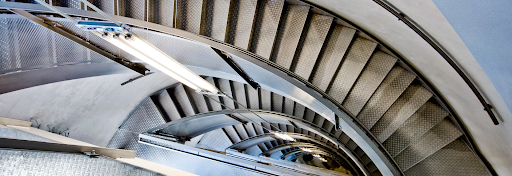Visma Megaflex is a leading provider of solutions that help Finnish companies manage people’s access to buildings and office spaces. These solutions connect hardware and software in a simple way, and have radically changed the industry.
Megaflex’s offering to each customer includes two parts:
- The hardware, also called the Greenbox, sits at the customer location and connects to existing hardware that controls building access.
- The cloud software collects data from the Greenbox and provides the customer with real-time information and tools in a web browser, accessible anywhere, at any time, from any device.
“The Greenbox has really revolutionised building access”, says Matilda Starck-Rantanen, Service Manager at Visma Megaflex. “Many buildings have old, clunky hardware that doesn’t share information very well. Our Greenbox is able to communicate with that hardware and give our customers more control and better insight into space efficiency, security, and the activity in and out of the building.”
Sustainability has always been top of mind at the company, but today it is prioritised more than ever. “We are very proud of what we have been able to do to make Greenbox more sustainable, not just in terms of materials but also its carbon footprint”, says Starck-Rantanen.
Learn what Visma is doing overall to reduce e-waste and its carbon footprint
6 changes for a more circular product
Visma Megaflex has focused on six areas of sustainability for its Greenbox product.
1. Changing the Greenbox case from plastic to metal
One of the most obvious parts to update was the plastic casing around the Greenbox product. By switching to metal, they have made the product both stronger and more sustainable.
“Metal turned out to be the cheaper material, but also the more durable, resulting in better quality. The metal case is recyclable and can be used several times for our product before it is put into metal waste”, says Starck-Rantanen.
2. Developing the product to be remotely controlled
One of the biggest expenses for Visma Megaflex is the cost of installers going on-site for repairs. This is also a significant source of CO2 emissions, as installers need to drive, sometimes very long distances.
Starck-Rantanen explains: “The product is continuously developed so that it should require as little on-site repair as possible. This saves us money and reduces emissions at the same time! Having a remotely controlled product is also a competitive edge for us since clients can then get their product fixed faster and more conveniently. For example, there’s now less and less need to schedule and wait for installers.”
3. Developing the product to use existing materials and as few new materials as possible
Visma Megaflex is continuously developing Greenbox to use as many existing materials as possible from customers’ buildings and IT environments. This saves the customer money because they don’t have to renew equipment, such as key tags, readers, locks, IT-infra networks, and so on.
“It is also more sustainable since we don’t always need to buy and use new physical products and materials to get our system up and running”, adds Starck-Rantanen.
4. Fitting in new technology in the existing product
For Visma Megaflex, it is important that their product is adaptable to new technologies and market needs. They have therefore developed Greenbox to be able to connect to new technologies without major adjustments or requirements that customers buy extra gadgetry.
Starck-Rantanen elaborates, “Making Greenbox so adaptable saves the customer money and is therefore good business for us since it gives us a competitive edge. But it is also sustainable since we don’t need to add extra materials or change big parts for our product to work with new technologies”.
5. A long lifetime
The Greenbox product is continuously developed to extend its lifeline. Currently, its lifeline is around 10 years, which is above the industry average for such hardware.
6. New sustainable partnerships
The company is currently mapping interest from customers to have the option to offset their emissions, for example compensating for the CO2 released when the Greenbox product is used in their buildings.
According to Starck-Rantanen, this is something they may implement in the future. “If there is enough interest this is something we might integrate, for example in collaboration with a gold-standard compensation organisation. This would be a competitive edge for us since competitors do not offer this. This would also be sustainable since the product could then be almost CO2 emission-free.”
Also read: Inside Visma Denmark’s brand new and sustainable office space
Closing the loop
The six areas described above are just a small part of Visma Megaflex’s goals to develop the company’s products and materials as efficiently as possible while minimising waste. Other sustainability focus areas for the company include financial responsibility, security, product safety and reliability, occupational safety and health, and overall well-being of employees in a fair, open, and secure environment.
“In a short time we have been able to achieve a lot in improving work safety and reducing e-waste, and in a way, our job is never done. There is always more we can do to have a better impact on our employees and the planet,” concludes Starck-Rantanen.

